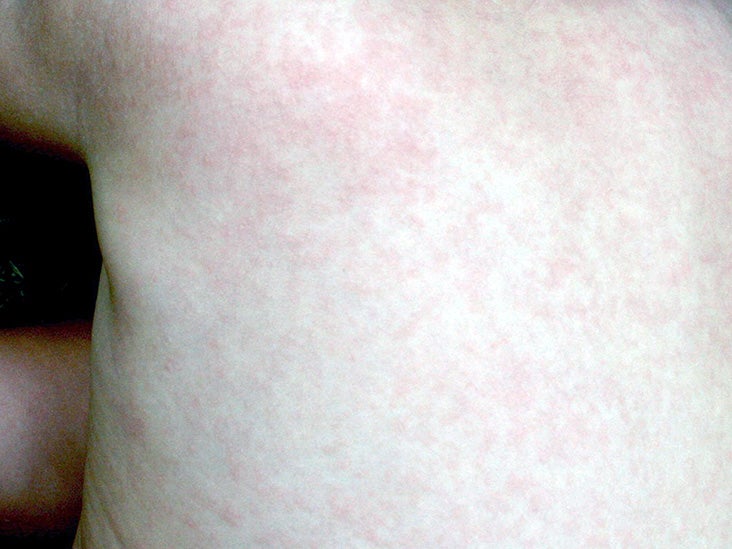Roseola rash: symptoms, pictures, and treatment - Medical News Today

Roseola rash occurs due to infection from a type of herpes virus. It typically affects babies and toddlers and people may confuse it with measles. However, both conditions have different causes, presentations, and complications.
Other names for this health issue are sixth disease, exanthema subitum, or just "roseola."
This article summarizes how to identify roseola and how to tell the difference between this illness and measles. It also examines whether treatment is necessary.
Roseola usually affects toddlers and babies under
- general discomfort
- irritability
- an unwillingness to eat
- diarrhea
- a cough
- swelling or redness around the eyes
- ear pain
- swollen glands
Roseola has a
- A high fever develops, possibly suddenly, and may last for 3–5 days.
- A distinctive rash appears, usually on the torso, as the fever ends.
- The rash may progress to the neck, face, and limbs within 12–24 hours.
- The rash disappears after 1–2 days.
The roseola rash may look like small pink spots or bumps that can merge into patches.
In some babies, the rash is reddish, and it may turn a lighter color when a person applies pressure. There can sometimes be a paler "halo" around the rash area.
The roseola rash does not usually cause pain, itchiness, or any blistering. It usually starts on the trunk of the body and can sometimes progress to the neck, face, arms, and legs.
About
Roseola results from infection with one of two main strains of the human herpesvirus (HHV): HHV-6 or HHV-7.
After infection, HHV-6 or HHV-7
These viruses belong to the Herpesviridae DNA virus family, of which eight can infect humans.
The other six viruses are:
- herpes simplex virus 1
- herpes simplex virus 2
- varicella-zoster virus
- Epstein-Barr virus
- cytomegalovirus
- Kaposi's sarcoma herpes virus.
Most herpes viruses, including those that cause roseola, transmit person-to-person through direct contact with someone who is infected.
Roseola and measles both cause rashes and are common during childhood. However, measles can also develop at any age, while roseola rarely affects adults. Find other important differences below.
Cause
Unlike roseola, which is
Rash appearance
Generally, a measles rash begins on the face and then moves downward. The rash takes 1-3 days to develop. Children with measles will also usually have a
The roseola rash, on the other hand,
Complications
Children with roseola usually recover with
However, a high fever can be a common symptom of roseola, and it causes febrile seizures in
It is also worth noting that babies and toddlers with weakened immune systems tend to experience more severe symptoms of this infection.
Also, the virus
Also, HHV-6 infection has been
People with measles often recover with no complications. However, some people
The risk of complications is higher in children and babies
Prevention
There is currently no vaccine for roseola. Measles, meanwhile, is a preventable illness with a very effective vaccine.
The vaccine is given in two doses: one when a baby is
In some cases, however, a child may need to get vaccinated on a different schedule. The Centers for Disease Control and Prevention (CDC)
There is
Do not use aspirin to treat pain for roseola. It may cause Reye's syndrome in children, which can be deadly.
It is important to let the baby rest and make sure that they receive plenty of fluids. It is important to follow good hygiene, such as by washing the hands frequently, to prevent the infection from spreading.
It is important to seek medical attention right away if a baby has a high fever, a persistent rash, or both.
If there are signs of a febrile seizure — a seizure brought on by a high fever — seek immediate care.
- moaning
- rolling eyes
- vomiting or urinating
- convulsing, shaking, or twitching
- losing consciousness
A doctor can diagnose roseola by checking for symptoms and considering their medical history. They may also use a blood test to support the diagnosis.
Anyone with a compromised immune system who comes into contact with a child who has roseola should receive medical advice.
Roseola is an infection that typically affects babies and toddlers. It causes a high fever that lasts for 3–5 days, then a rash that starts on the trunk and can move to the rest of the body. The rash is very distinct, and it progresses in a characteristic pattern, starting from the torso.
There is no specific treatment or vaccine. Usually, roseola will resolve within about a week. An age-appropriate dosage of ibuprofen (Advil) or acetaminophen (Tylenol) can usually reduce the fever.
Comments
Post a Comment